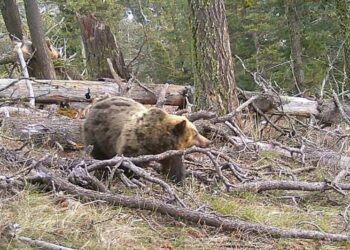Pneumonia outbreak coupled with severe winter kills thousands of antelope
By Benjamin Polley EBS COLUMNIST

Thousands of pronghorn antelope make one of the longest land migrations in the continental United States each spring and fall. In just two to three days, they travel 100-150 miles, fleeing Grand Teton National Park’s high country and heading south to lower elevation wintering range along the Upper Green River Basin of southwestern Wyoming.
Pronghorns instinctually migrate from summer’s high plains birthing grounds to wind-swept pockets of tawny-brown winter grass and sagebrush hoping to seek shelter from deep winter snows. They face many obstacles along this migration, navigating highways and interstates, energy exploration and development, subdivisions, and barbwire fences. This past winter season came early and never relinquished its hold. It was fraught with melt-and-freeze cycles that created multiple layers of ice, making foraging difficult for antelope with their small legs, which aren’t built to withstand harsh winters. The severe winter caused many antelope to starve, with as many as half of some herds dying from hunger.
On top of that, pneumonia outbreaks have already stricken many antelope herds. But it wasn’t just winter forcing pronghorn numbers to decline in Wyoming. Others that didn’t die fled to browner pastures in Colorado.
Antelope evolved on the North American continent over 30 million years ago beside the American cheetah, each driving the other’s evolution in determining speed to survive. A pronghorn can run 65 mph, once allowing it to escape and outrun the cheetah, but the latter is now extinct. Pronghorns are more closely related to mountain goats than antelope, although rather than rocky faces, pronghorns need wide open, undeveloped plains ranging from 3,000- to 6,000-foot elevations. High winds usually swept large parts of the Green River Basin free of snow. Biologists estimate there used to be 20 million pronghorns across the high-elevation prairies of the Great Plains, spanning from southern Canada to northern Mexico. Now their numbers, estimated at around 800,000 animals, are relegated to Arizona, northeastern California, Colorado, Montana, New Mexico, Oregon, and the western Great Plains states—including Wyoming, where half of all pronghorns live, with the largest populations being found in the Red Desert and the Greater Yellowstone ecosystem.
A few years ago, Wyoming could say it had more antelope than people, but the herd numbers have decreased recently, especially this year.
Winter came in November to Wyoming, covering the state’s entire western and southern regions in snow. It continued stacking up all season. Temperatures around the Baggs area on the Colorado border had numerous freeze-thaw cycles, which made for a very hard snowpack, creating varying layers of cement-like crust covering the forage and making it nearly impossible for mule deer and pronghorn to get to the vegetation. Many areas received 150% more than the annual average snowpacks, with 20-plus inches on top of the usual.
“Models said we were anywhere from a foot to two feet more snow than normal,” said Philip Damm, Wyoming Game and Fish biologist.
As snow accumulated throughout the region, pronghorns couldn’t find snow-free pockets. Many pronghorns died from starvation after already being weakened by pneumonia. Wyoming Game and Fish officials estimate more than 500 died because of the bacteria Mycoplasma bovis, a form of pneumonia. Some animals were so weak they died on the sides of roads, while vehicle collisions killed many others—another reason to build more wildlife bridges.
Over half of some herds died from malnutrition, even in their winter ranges. Many died near juniper trees, the only source of vegetation and sustenance sticking above winter’s white blanket.
“Winter may be over, but winter mortality typically extends into May as many animals get too far gone, even after vegetation improves and temperatures warm. They can’t recover from such poor body condition. I would expect to see that number climb,” Damm said.
But what if they can’t find food?
“Pronghorn are built to move and get out of winter. They are not built to withstand deep snow, so they migrate,” Damm said.
Snow was so deep that they walked over the tops of fences instead of going through or underneath the lowest rung of barbwire, which they usually do. Pronghorns evolved for speed and can barely jump. Many of them continued walking south over fences, ending up in Colorado.
“People in Wyoming have a saying that we lost our antelope to Colorado,” Damm said. “In the winter, they walk on hardpack snow right over the top of fences, but when the snow melts, they can’t walk over the fences anymore and get stuck across the state line.”
Fortunately, pronghorns often have twins. They can rebuild their numbers quickly if the population can get a 95% survival rate through several light winters. It might take three-10 years to do so, and Wyoming Game and Fish are discussing the possibility of issuing 10,290 fewer antelope tags this year to help populations recover.
“Female pronghorns can produce excellent numbers of fawns,” Damm said. “In subsequent years after these difficult winters, we frequently see a pretty good jump in fawns’ productivity. The direct result of winter mortality is way below the carrying capacity of the landscape with plenty of these resources for these critters to get into.”
At least mortalities caused by winter’s severity and pneumonia are natural challenges that pronghorns face in any given year. Even in a good winter, there’s usually a yearly 10-20% antelope die-off.
In contrast, habitat destruction from oil and gas development, fences and subdivisions, and deaths from vehicle collisions are not natural and are ever-growing obstacles that pronghorns face. Less habitat on the landscape leads to fewer resources and fewer antelope numbers. Fortunately, more conservation organizations are finding ways for animals to move and thrive in an ever-growing human world. Overall, Wyoming has some of the best big game numbers in the country and has been ahead of the curve in constructing wildlife bridges and underpasses, guiding wildlife safely across highways and interstates, and helping to mitigate deaths.
Benjamin Alva Polley is a place-based storyteller with stories published in Outside, Adventure Journal, Popular Science, Field & Stream, Esquire, Sierra, Audubon, Earth Island Journal, Modern Huntsman, and other publications at his website www.benjaminpolley.com/stories. He holds a master’s in Environmental Science and Natural Resource Journalism from the University of Montana.












